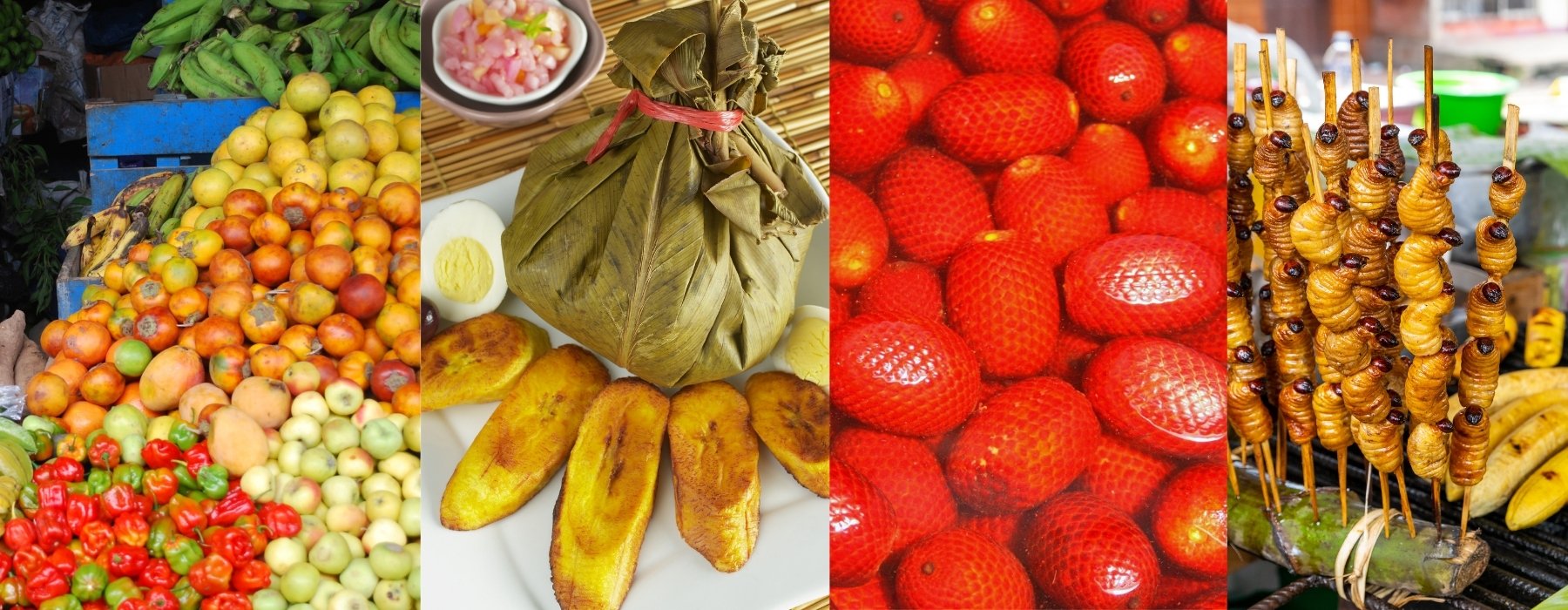
Discover the gastronomy of Iquitos, this unique gastronomy is an invitation to live a culinary adventure that transcends the conventional. It is an opportunity to connect with ancient traditions and taste the authentic essence of the Amazon. Each dish is a work of art that reflects the respect for nature and the creativity of its people. Without a doubt, Amazonian gastronomy not only captivates the palate, but also opens the heart and mind to new experiences and sensations. So, if you are looking for a destination that offers a unique and exciting culinary experience, the city of Iquitos in the Peruvian Amazon awaits you with open arms. Come and let yourself be seduced by the flavors, aromas and colors of one of the most exotic and least explored cuisines in the world. Your unforgettable gastronomic adventure begins here!
If there is a phrase to describe the varied gastronomy of Iquitos, that phrase is “culinary delight.” The cuisine of the Peruvian Amazon not only welcomes us with its exotic dishes, but also attracts the traveler with its great variety of culinary delights.
The biodiversity of its resources seems endless. Chonta or palm heart, which is obtained from palm trees, is a basic product of Amazonian cuisine and is used to make salads. The meats consumed are diverse: beef, poultry, fish, lamb and other species of the forest, such as majaz, well known in the area for its rich flavor and low fat content. Plantain is another basic ingredient of Amazonian meals. It is used to prepare tacacho, which is accompanied with chicharrones or cecina (dried meat). Juanes, pieces of chicken wrapped in cooked rice and covered with bijao leaves to be cooked; roasted picuro, a species similar to guinea pig; apichado, pieces of pork stewed with peanuts and corn; and fish patarashca are other examples of flavors offered by Amazonian tables.
And what better way to accompany this tempting gastronomy than with the juice of countless fruits and other drinks, of which feijoa, borojo, arazá, copoazú, camu camu and açaí stand out. A wide variety of drinks are prepared with them, which further delight the spoiled palates of visitors. The gastronomy of eastern Peru is exotic.
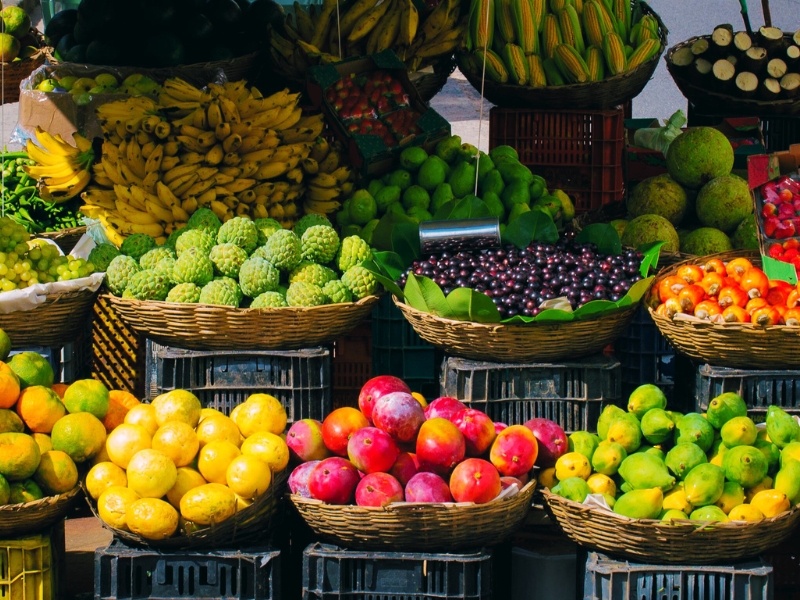
To immerse yourself in its cuisine is to explore an essential part of the Amazonian identity, where each dish tells a story of connection between man and nature. In this corner of the world, food is not just sustenance; it is a celebration of life, community and the natural environment.
The Loreto region is home to numerous indigenous ethnic groups, each with their own culinary techniques and preferences that have been passed down from generation to generation. Here, ingredients are harvested directly from the jungle, ensuring unparalleled freshness and flavor. Manioc, also known as yuca, is the base of many dishes. But what really makes Amazonian cuisine unique is its use of exotic ingredients such as freshwater fish, tropical fruits, and even insects, each providing a unique flavor that challenges the palate.
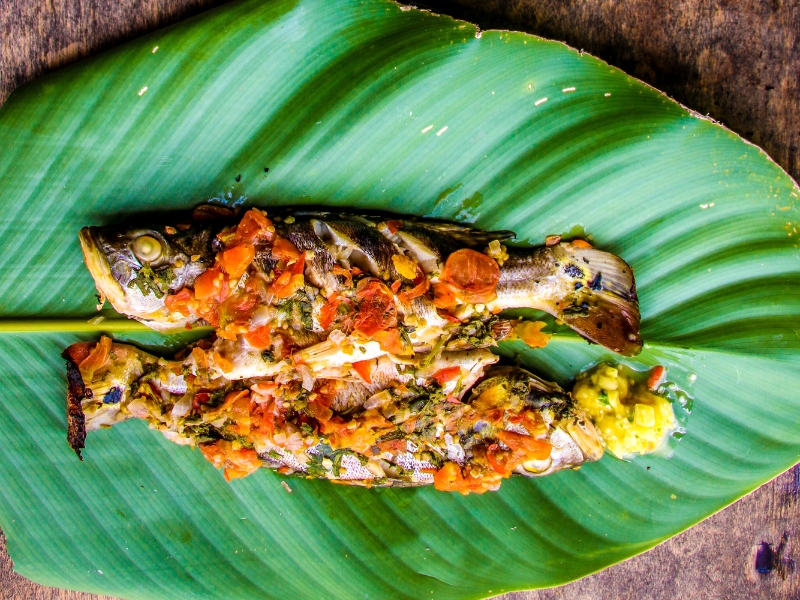
Patarashca is a culinary technique of Amazonian origin that has conquered the palates not only of the jungle region, but of all of Peru and beyond its borders. This ancient technique consists of wrapping pieces of fresh fish, seasoned with aromatic herbs and wrapped in bijao leaves, to then be cooked on the embers, achieving a unique flavor and a juicy and delicate texture. It is believed that Patarashca has its roots in the ancient culinary traditions of the indigenous communities of the Peruvian Amazon, who used the natural resources of the jungle to prepare their food in a simple but delicious way. The use of bijao leaves as a wrapper not only provides a characteristic aroma, but also helps preserve the moisture and natural flavors of the fish during cooking.
In the preparation of Patarashca, fish species native to the Amazon region are mainly used, such as paiche, doncella, gamitana or boquichico, which provide unique and fresh flavors to this traditional dish. In addition to fish, Patarashca includes a variety of ingredients and natural elements that enhance its flavor and give it a special touch. Among the most common are yellow chili, cilantro, garlic, tomato and onion, which combine to create an aromatic and delicious mixture.
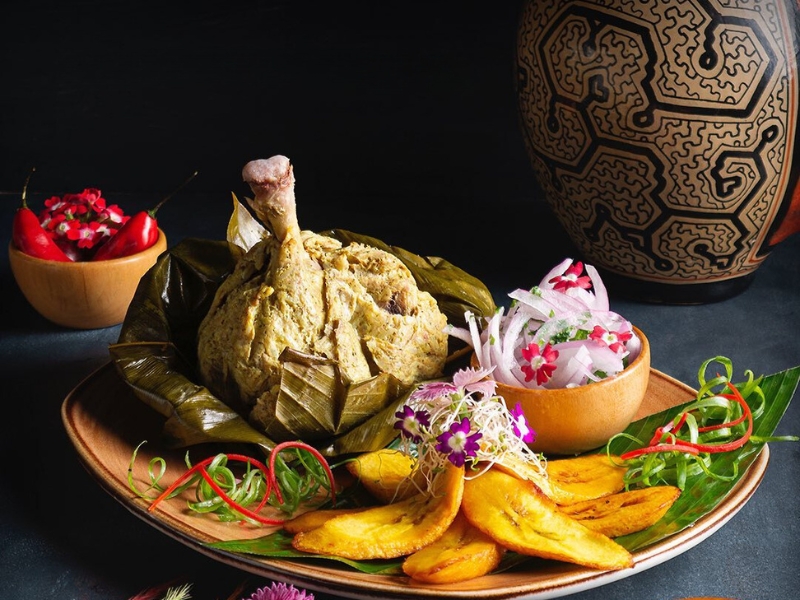
Perhaps the most iconic of Iquitos’ typical dishes, the juane is an emblem of the San Juan festivities, celebrated every June 24. Made from rice mixed with turmeric or a stick, it is filled with a piece of chicken, hard-boiled egg, olives and spices that provide an unmatched flavor. This mixture is wrapped in bijao leaves (similar to banana leaves) to be steamed or boiled. Its flavor stands out due to the complexity of Amazonian spices, and its firm texture makes it a generous bite. It is not unusual to see it accompanied by a regional chorizo, thus expanding the experience. This dish symbolizes the fusion of cultural influences and is one of the typical dishes of Iquitos that should not be missed.
There are some varieties of juanes such as the Juane de arroz, made from rice and chicken; the Avispajuane, with ground beef; the Ninajuane, with chicken and egg; Chuchullijuane, with rice and chicken giblets, and Uchujuane, with fish, egg and chili. Another variety is Sarajuane, which contains peanuts, corn and guinea pig meat.
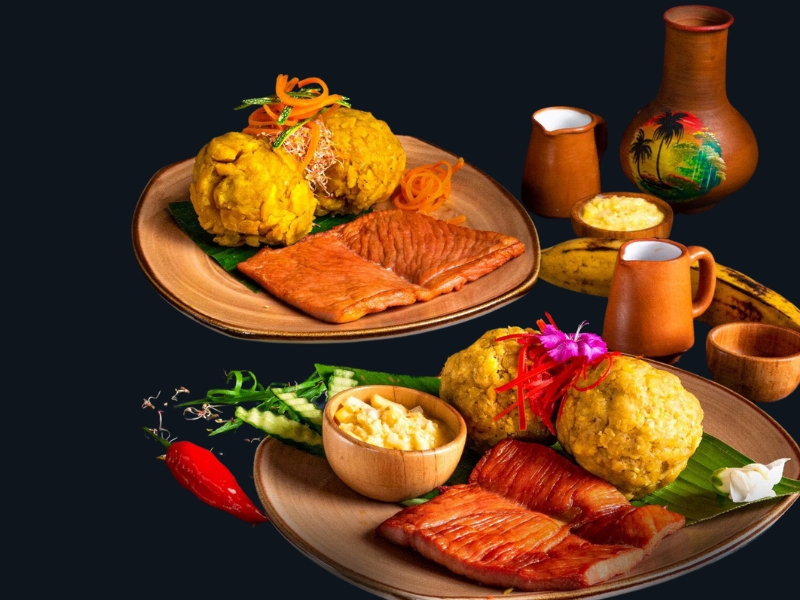
Tacacho with Cecina (pig jerky) is a typical dish of Peruvian cuisine, popular in the Peruvian jungle and widely spread in the rest of the country. Its name comes from the Quechua word “taka chu” which means “beaten.” It adopts this name due to the particularity of its process before becoming a rounded banana shape mixed with tiny pieces of pork rinds, which determine an unparalleled flavor.
It is one of the dishes of the jungle prepared with fried green banana and crushed into a round dough, seasoned with lard accompanied with pig jerky, the name by which smoked pork is known throughout the country and the most popular consumed during the San Juan Festival. It is a culinary treasure not only for its great flavor but also for its nutritional value. Tacacho with Cecina is usually served with Amazonian chorizo and cocona sauce.
Its consumption varies depending on the region where it is prepared and cooked for breakfast and accompanied with coffee or a fruit drink, while in other regions of the jungle it is consumed for lunch or dinner.
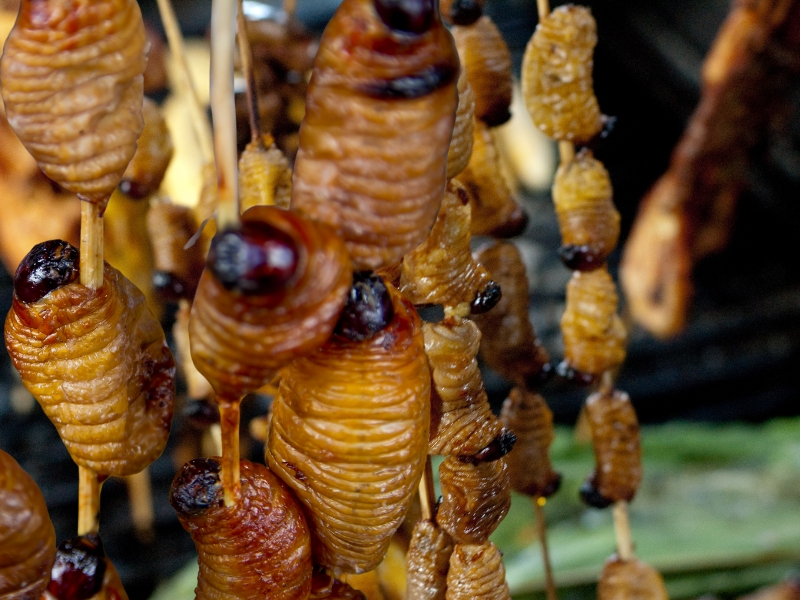
The suri (beetle larva), plump and rough, five to seven centimetres long, cream-coloured, and topped by a sort of rigid mahogany-coloured head, crowned by conical jaws, is grilled to enjoy its smoky flavour and soft texture. It is an energetic and nutritious food that can be enjoyed as an appetizer or on skewers. It is often served with chifles, yuca or rice to complete the experience. Many visitors consider it one of the most unusual typical dishes of Iquitos, but essential to understand the variety of the local diet.
It reproduces in the stem of the aguaje or decomposing palmetto trees and is one of the most prized morsels of the Amazon rainforest, especially in the gastronomy of Iquitos, where it is consumed raw, cooked or toasted as an anticucho. It is an excellent source of protein, vitamins A and E and minerals, as well as being very tasty.
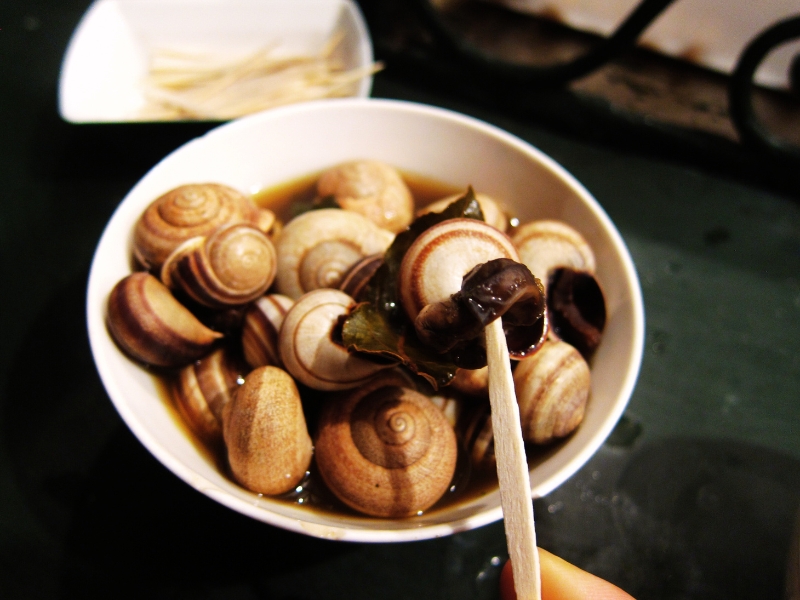
Churos are river snails, and their meat is cooked and then served in a spiced broth or stew. They are a rich source of protein and add a unique touch to Peruvian food. Their versatility allows them to be used in soups, stews and even ceviches, reflecting the creativity with which uncommon ingredients are incorporated into the daily diet.
While in countries such as France, Spain or Portugal the land snail is considered a delicacy, in the Amazonian department of Iquitos there is a variety of giant river snail (known as Churo) that is highly sought after for stews based on chili peppers, onions and tomatoes.
This mollusk is also a great source of iron and protein and a solution to combat anemia and malnutrition in its area of origin. In Lima, some restaurants such as Maido have prepared them with a dale dale emulsion in a gourmet version.
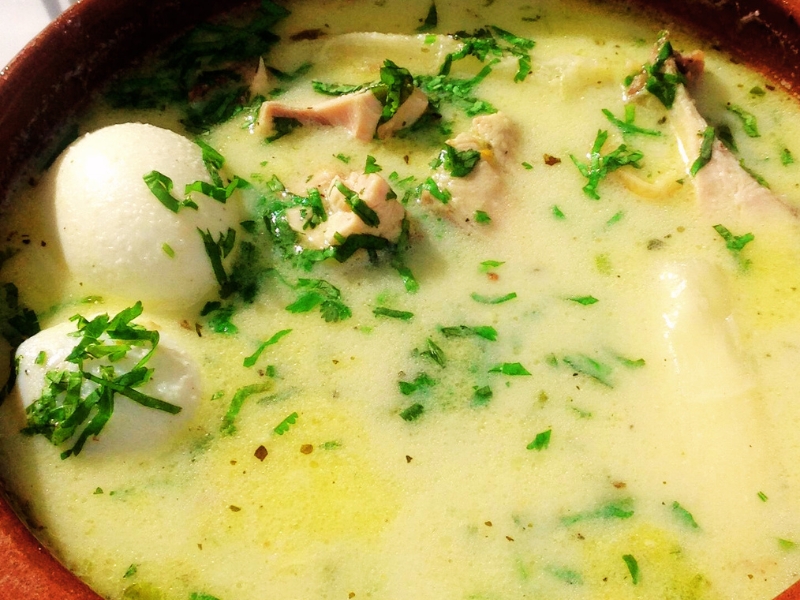
Inchicapi, a Quechua word formed by the words “inchi” meaning peanut and “capi” meaning soup, emerged in the rural Amazon as a nutritious and consistent stew capable of restoring the energy of farmers, fishermen and other workers after a demanding work day. Therefore, its main ingredients are peanuts, corn flour, sachaculantro and chicken meat that provide the calories and nutrients required to successfully cope with physical and mental wear and tear.
Peanuts contain carbohydrates, proteins and vitamins and minerals such as magnesium that contribute to the proper functioning of the nervous, muscular and immune systems. It also provides essential fatty acids for good cardiovascular health. Corn, on the other hand, is a good source of energy. The starch it contains is called resistant starch, which is more difficult for the body to break down. An additional advantage of corn is that it is particularly rich in carotenoids, lutein and zeaxanthin, which are excellent for maintaining eye health.
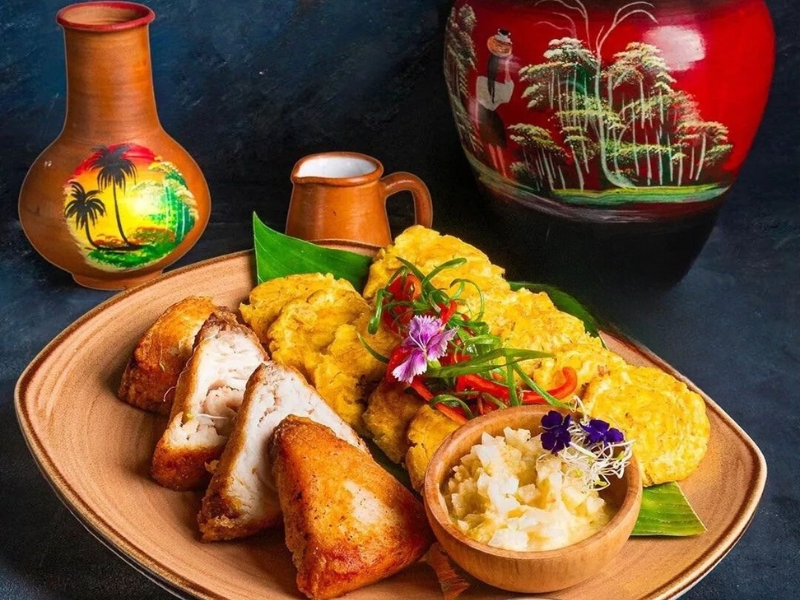
The paiche is one of the largest freshwater fish in the world. Its meat is highly appreciated by local inhabitants of the Amazon rainforest of Peru. These fish in the wild inhabit the extensive rivers and lagoons in the vast territory of Loreto. Occasionally they are hunted with harpoons and arrows. But nowadays there are many farms where they are raised to take advantage of their meat, and sell it in the different local markets. Delicious stews are prepared with its meat. The most delicious is the fried paiche which is accompanied by a portion of rice, yuca, fried plantain and onion salad with cocona cream and aji charapita.
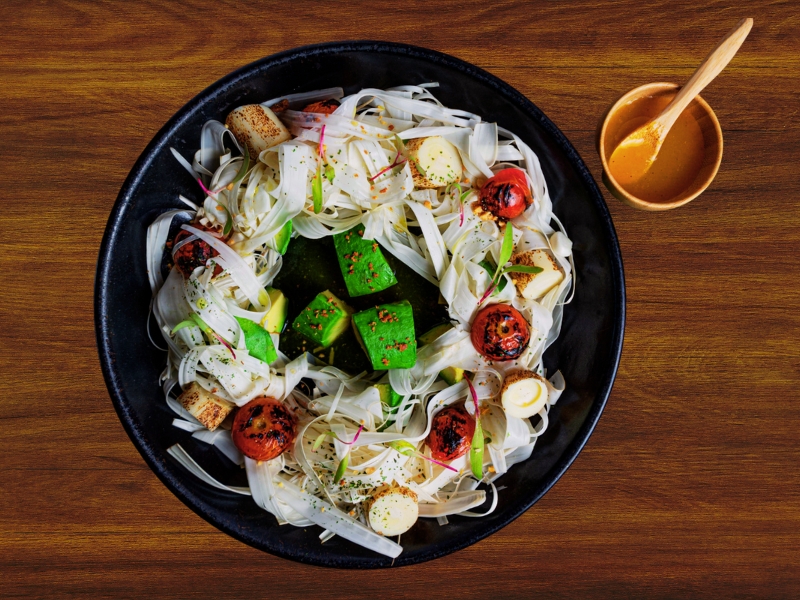
Chonta salad is a traditional dish from the Peruvian jungle that stands out for its freshness and combination of flavors. Chonta salad combines thinly sliced chonta with tomatoes, onions, cilantro, and lemon. Chonta is the tender shoot of the heart of palm, a plant found in tropical rainforests. Its mild flavor and crunchy texture make chonta a unique ingredient in this typical Peruvian jungle salad.
Chonta salad is not only delicious, but it also provides nutritional benefits. Chonta is rich in fiber, vitamins, and minerals, making it a healthy Peruvian ingredient to include in your diet. In addition, the other fresh ingredients add vitamins and antioxidants, making this salad a nutritious and balanced option.
Chonta salad has a rich history rooted in Peruvian Amazonian culture. Since ancient times, indigenous communities in the jungle have used chonta as a staple food and have created various culinary preparations with this special ingredient.
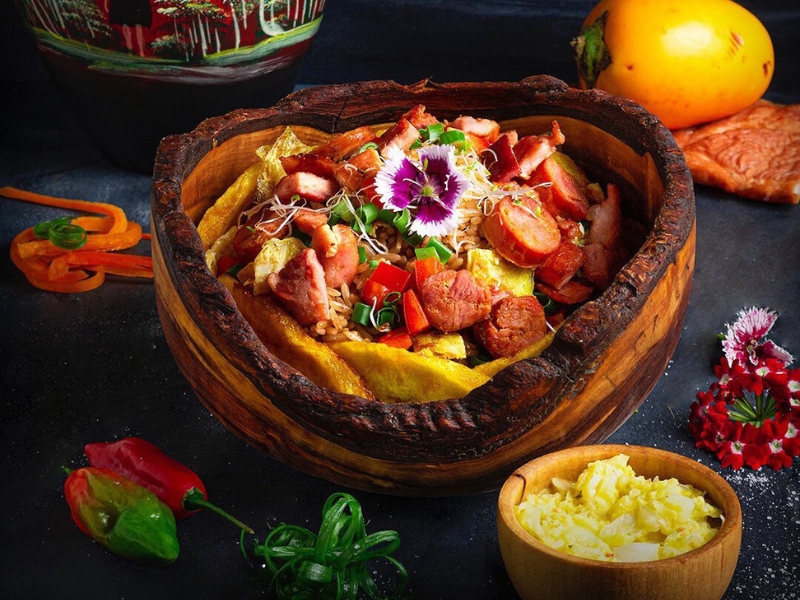
This delicious fried rice is a traditional dish from the Peruvian jungle cuisine. The history of this dish dates back to the arrival of Chinese immigrants to Peru at the end of the 19th century. They were workers who performed all kinds of tasks on the country’s coastal farms. As part of the payment for their work days, they received a daily ration of rice combined with spices. The use of this ingredient and others brought from the eastern country such as soy sauce and ginger, helped to create an original dish that used frying pan cooking techniques, receiving the name of fried rice from the Cantonese word Chaofan, which means fried rice.
Then in the Amazon jungle, local inhabitants began to cook it, adding native ingredients such as chorizo with beef ash, fried plantain, pepper and Cocona. Which give a unique flavor to this dish.
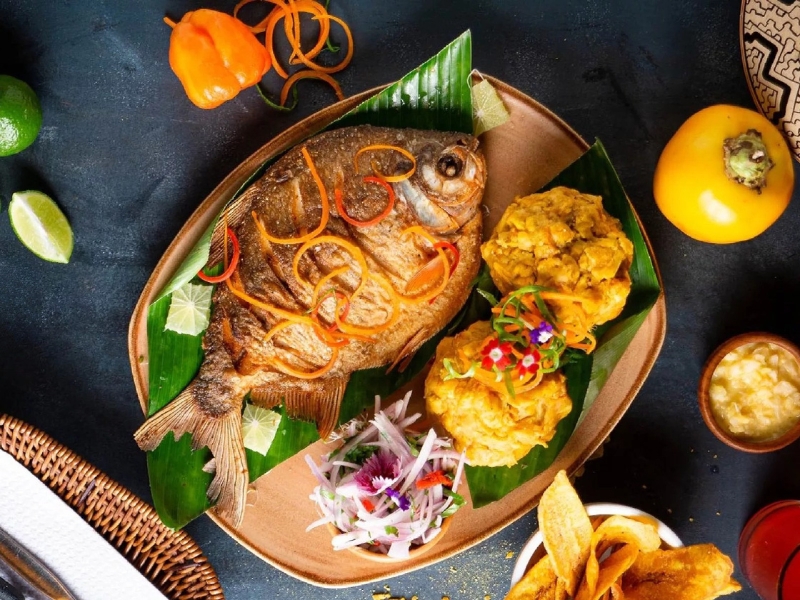
Fried Pomfret is a classic dish from the Peruvian jungle that consists of fillets of pomfret, a typical fish of the region, seasoned with lemon, garlic and spices, and then fried until golden and crispy. It is accompanied by rice and salad, and its fresh flavor and crunchy texture make it irresistible to fish lovers.
Pomfret is a fish with very small scales, almost circular in shape. It is a semi-fatty fish (5% fat), with a good source of high biological value proteins, as well as minerals (potassium, phosphorus, magnesium and sodium) and B vitamins, such as B3 and B12 and unsaturated fats. Vitamin B12 is present in significant quantities, as it exceeds that contained in eggs and most meats. This vitamin has important functions since its adequate supply is essential for the maturation of red blood cells, the formation of genetic material and the proper functioning of neurons.
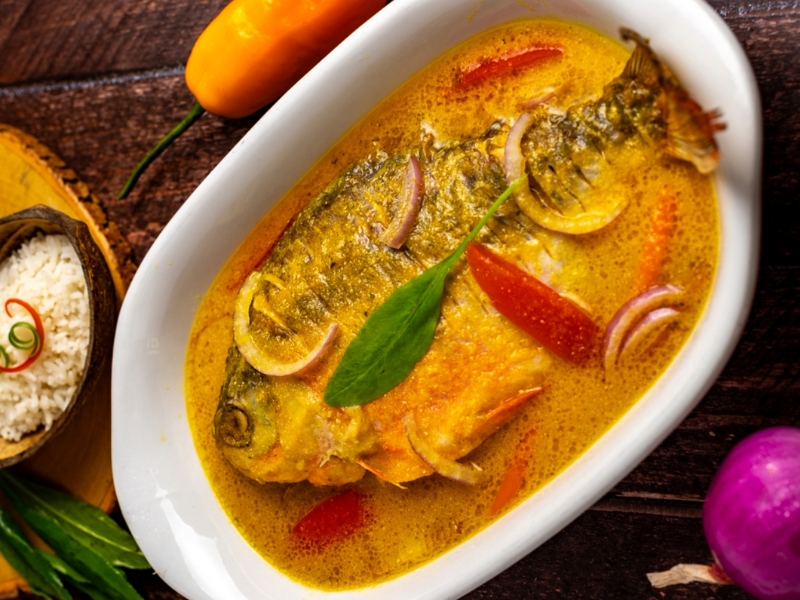
The Sudado is a typical dish from the Peruvian jungle that is prepared using river fish as a base. This typical Peruvian dish is characterized by its preparation steamed or in an aromatic broth, which gives it an intense and delicious flavor. Garlic, pepper, salt and chicha de jora are added as part of its main ingredients. It is a meal that is served with boiled yucca with onion, tomato, sachaculantro and lemon. It is accompanied with white rice.
The history of the Sudado goes back to the roots of Peruvian cuisine, where indigenous, Spanish and Afro-Peruvian influences merge to create a mix of unique flavors and culinary techniques. The Fish Stew is a Peruvian food dish that originated in the coastal areas of Peru, where fresh fish is abundant.
Sudado de Pescado also reflects the Afro-Peruvian influence, as it uses spices and aromatic herbs such as yellow chili, which give it a spicy and distinctive touch.
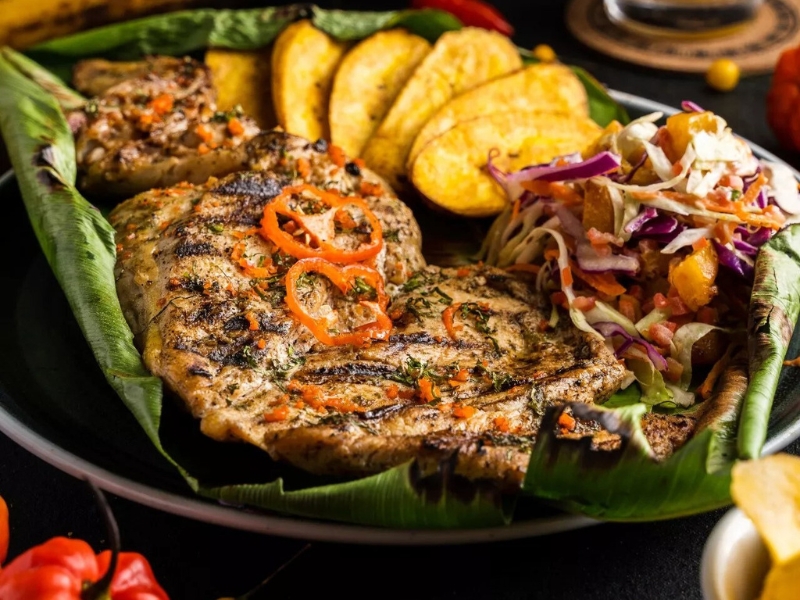
If you love grilled meats in Iquitos, you will enjoy exquisite meat, both chicken and beef. Local restaurants prepare this delicious dish using local ingredients such as stick, ginger, sachaculantro, and charapita chili. This dish is served with a portion of fried plantains, yuca, and rice.
To give it more flavor, the meat is tied with a Bijao leaf, where it is cooked over a slow fire, absorbing the flavors of the ingredients.
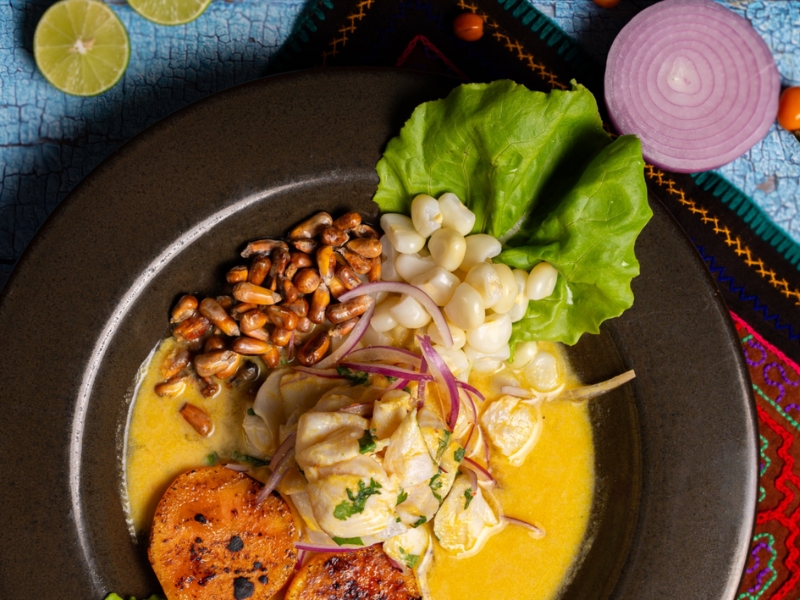
Ceviche is a dish that dates back many millennia. The first to use fresh fish meat was the Moche culture that settled on the northern coast of Peru. Originally this dish was prepared with short pieces of fish such as grouper, sole, and horse mackerel, which were marinated in chicha or the juice of the Tumbo fruit, which is a very acidic fruit. Since those years, trade and exchange with the ethnic groups of the Amazon was very intense, perhaps this is how the people of the Amazon brought the recipe for this dish.
But in the jungle, the meat of local fish is used, such as the Paiche, which is tender and very tasty. Additionally, the flavor of Amazonian chili peppers, cocona and the herb Sachaculantro are added, which considerably improve the quality of Amazonian ceviche. This dish is served with a garnish of yucca, fried plantains, corn, and onion.
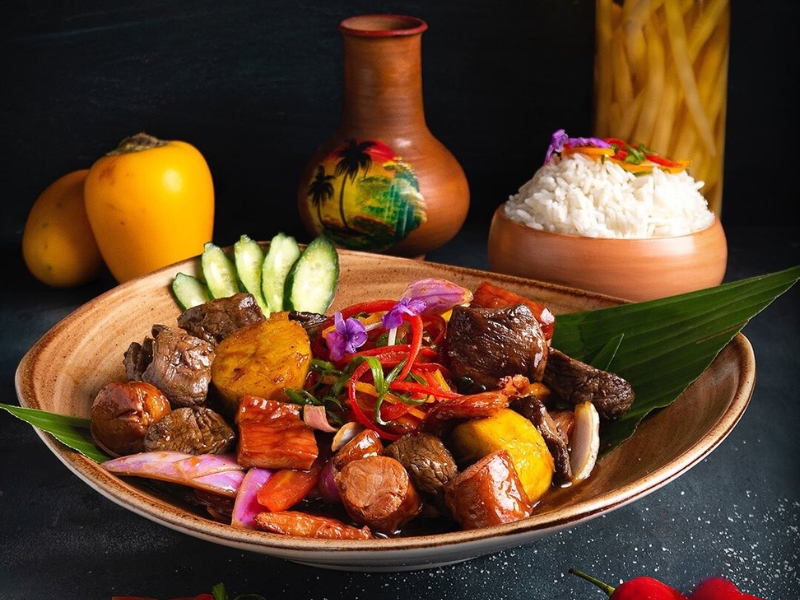
Lomo Saltado is a typical dish of Peruvian cuisine, which originated in the late 19th century, when Cantonese cooks introduced the wok cooking technique (a Chinese frying pan used to sauté food) to Lima kitchens, which quickly became a hit. The presentation of this dish in its beginnings was only beef tenderloin and French fries. With the arrival of Asian immigrants, sautéed vegetables were added.
The preparation of Amazonian Lomo Saltado is very particular. First, the previously seasoned beef is cut into small pieces and fried in a frying pan or wok over high heat. Once cooked, chopped onion, tomato, and yellow chili are added. After a few seconds, soy sauce and vinegar are added, then chopped sachaculantro is added. It is served with rice, fried yucca, and fried plantain.
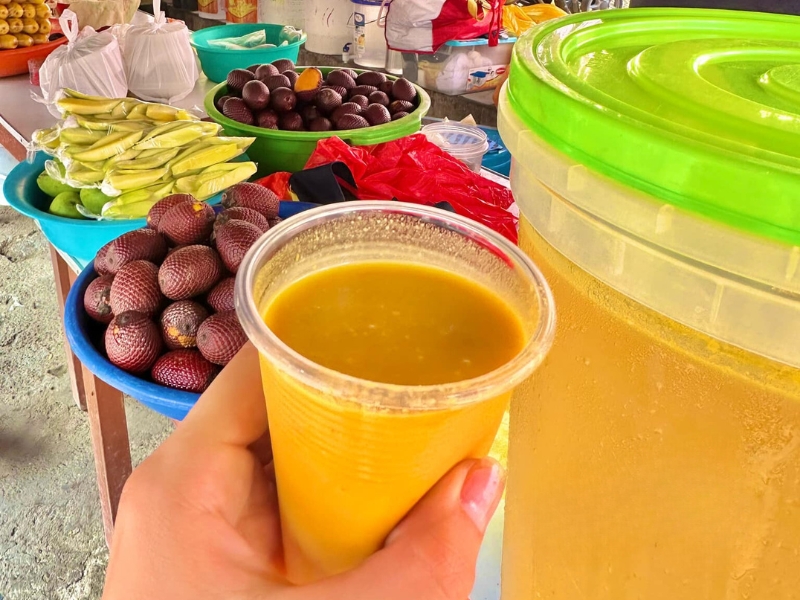
Aguajina is a delicious refreshing drink originating from the Peruvian jungle. This drink is made from aguaje, a tropical fruit that is very popular in the Amazon region of Peru. It is the fruit of a palm tree that grows in flood zones called aguajales, and is known for having a high content of vitamin A, higher than carrots and spinach. For this reason, it promotes eye health and helps maintain healthy skin.
This Amazonian superfood also contains a high concentration of vitamin C, which helps in the absorption of iron and calcium, thus contributing to strengthening bones and muscles, preventing osteoporosis and other related ailments.
Aguaje contains phytoestrogen, a plant compound that has antibiotic, analgesic, anti-inflammatory and anticancer effects, especially against breast, colon and prostate tumors. It also prevents cardiovascular diseases and strokes.
This fruit plays a vital role in the chain of tropical jungle forests, as it is an important food for animals such as peccaries, sachavacas, monkeys, majaz, as well as various species of birds and fish.
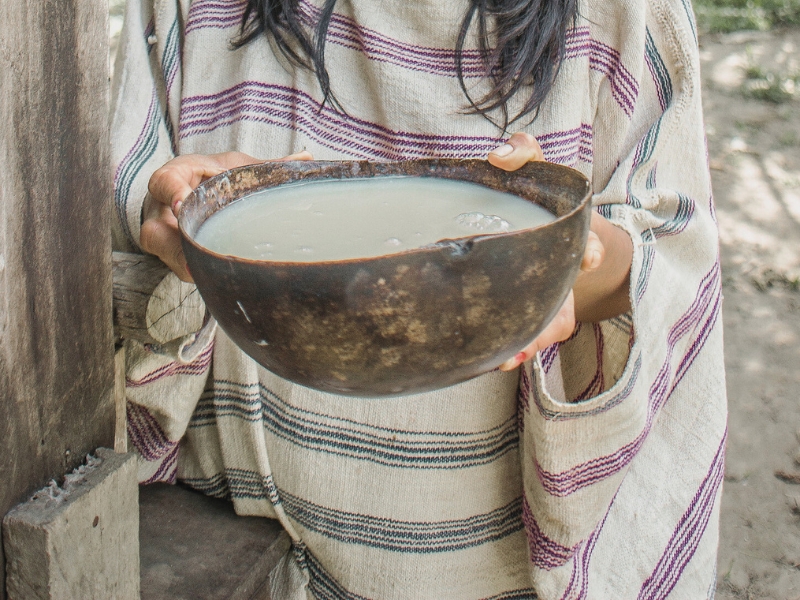
Masato is a traditional drink from the Peruvian jungle, prepared with fermented yuca. It is also called chicha de yuca, although in other regions the ingredients vary. Masato was originally prepared by the native tribes of the jungle, who after boiling the yuca, placed it in a mill to crush it with a wooden mallet. Later, they mixed part of it with the cooking water, and the rest of the crushed yuca was chewed by the women of the tribe, so that their saliva would produce the enzymes for the transformation of the yuca starches and the subsequent fermentation. This product was then mixed with the yuca and water and placed in containers covered with bijao or banana leaves to finish fermenting for about a week.
The natives consume masato as an alcoholic beverage, especially in their traditional celebrations. It is also consumed as a soft drink to quench thirst when it is half fermented. It is customary for tribes to welcome foreigners by offering them a vessel of masato, and they must drink at least a sip to be treated well, otherwise they will take it as an offense and distrust them.
There are four types of cassava masato: mixed with sugar or honey, mixed with sugarcane broth, mixed with sweet potato, and chewed and mixed with saliva.
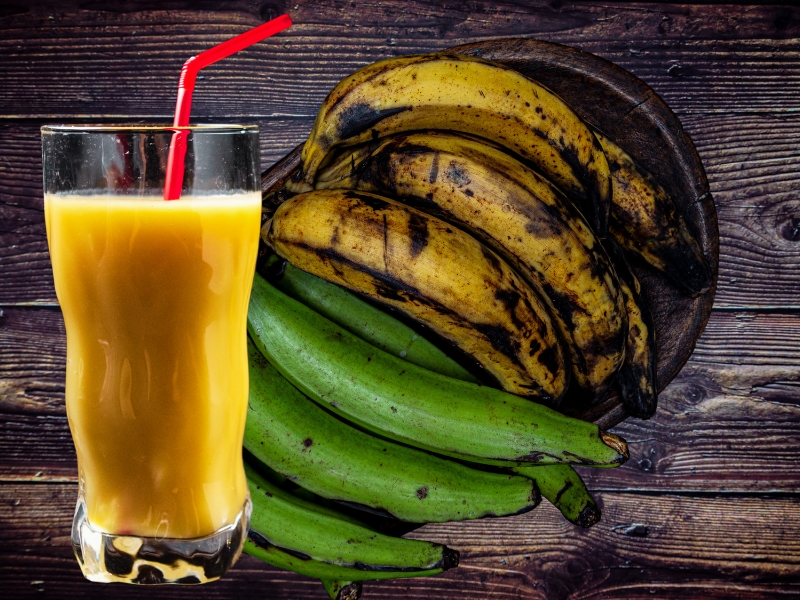
It is one of the most common typical drinks of the Peruvian jungle and that is due to its easy preparation with ripe plantain, boiled with cinnamon and cloves, which is blended or mashed until obtaining the desired texture. It is generally the hot drink that is taken for breakfast or even at dinner. But it can also be enjoyed cold as a soft drink for lunch.
The ripe plantain is a variety of banana that is distinguished by its sweet flavor and creamy texture when ripe. With a high content of carbohydrates and natural sugars, it is an excellent source of quick and sustained energy, ideal for before or after exercise. It is full of essential vitamins and minerals, such as vitamin C, vitamin B6, potassium and magnesium, which are essential for the proper functioning of the body and general health. Its potassium content can help control blood pressure and reduce the risk of cardiovascular disease.
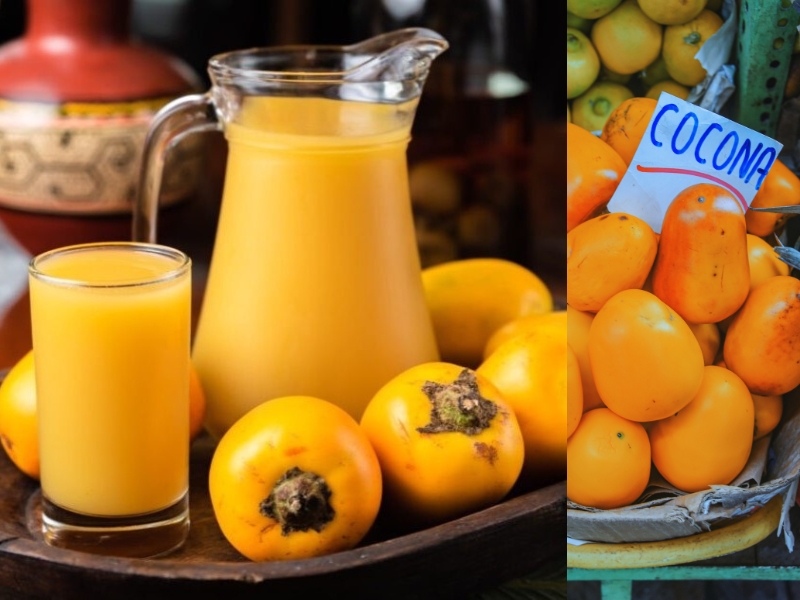
Cocona is an Amazonian fruit with a sweet and sour taste that is used to prepare a refreshing and delicious soft drink. This deep red fruit is characterized by its unique flavor, which combines sour and sweet notes. Cocona soda is made by extracting the juice from the fruit and mixing it with water and sugar to taste. This soft drink is especially popular during hot days in the jungle, as its refreshing taste and high water content help to hydrate and revitalize.
Its color and shape vary, some are larger and reddish in color, while there are also small and yellow ones. It has carbohydrates, iron, vitamin B5, calcium, phosphorus, carotene, thiamine, vitamin B12. Cocona effectively contributes to preventing colds mainly thanks to its high content of vitamin C. Cocona contains antioxidants that protect cells from aging caused by free radicals anti-aging benefits.
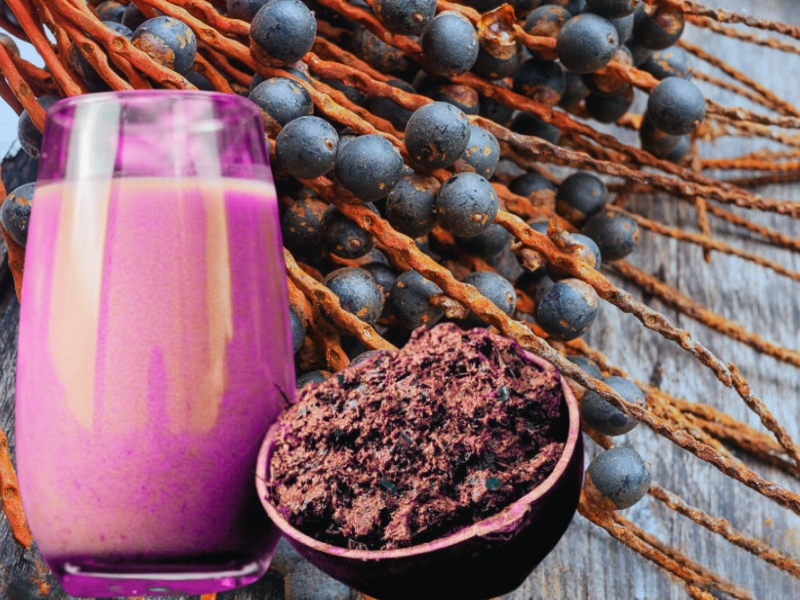
Ungurahui is an Amazonian palm tree whose fruits produce a nutrient-rich oil. However, it can also be used to prepare a delicious soft drink. Ungurahui soda is appreciated for its smooth, slightly sweet flavor, reminiscent of coconut with a distinctive twist. To prepare it, the juice is extracted from the fruits and mixed with water and sugar to create a refreshing and nutritious drink. In addition to its exquisite flavor, ungurahui soda is valued for its high content of antioxidants and essential fatty acids, making it a healthy and revitalizing option.
These natural jungle fruit juices and sodas are a great way to enjoy the authentic flavors of the Peruvian jungle while obtaining vital nutrients for the body.
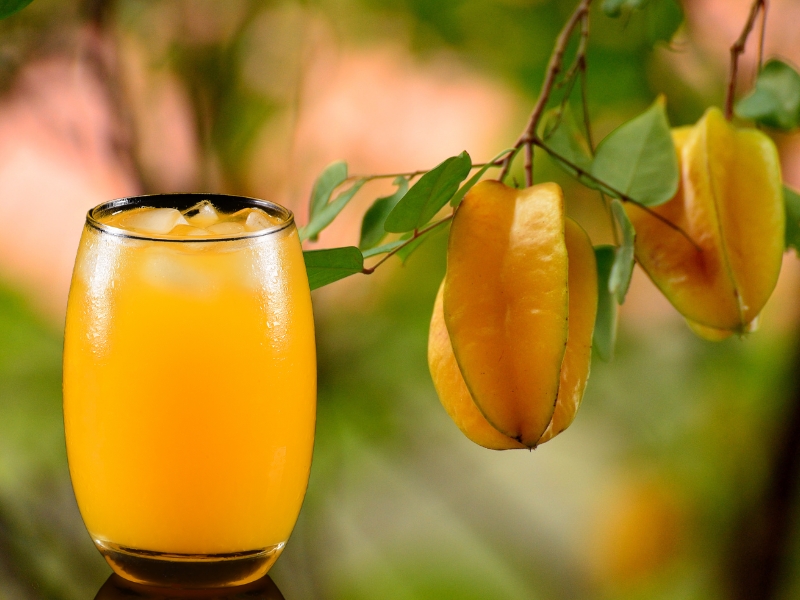
Carambola, also known as star fruit, is another tropical fruit found in the Peruvian jungle. Its refreshing and slightly acidic taste makes it a popular choice for making delicious soft drinks.
Carambola soda is made by slicing the fruit and mixing it with water and sugar, creating a refreshing and flavorful drink. In addition to being an excellent option to beat the heat, carambola is rich in vitamin C, fiber and antioxidants, making it a healthy choice for the whole family.
These jungle drinks are much more than just soft drinks; they are an explosion of tropical flavors that offer a delicious and healthy way to stay hydrated and cool in the hot climate of the Peruvian jungle.
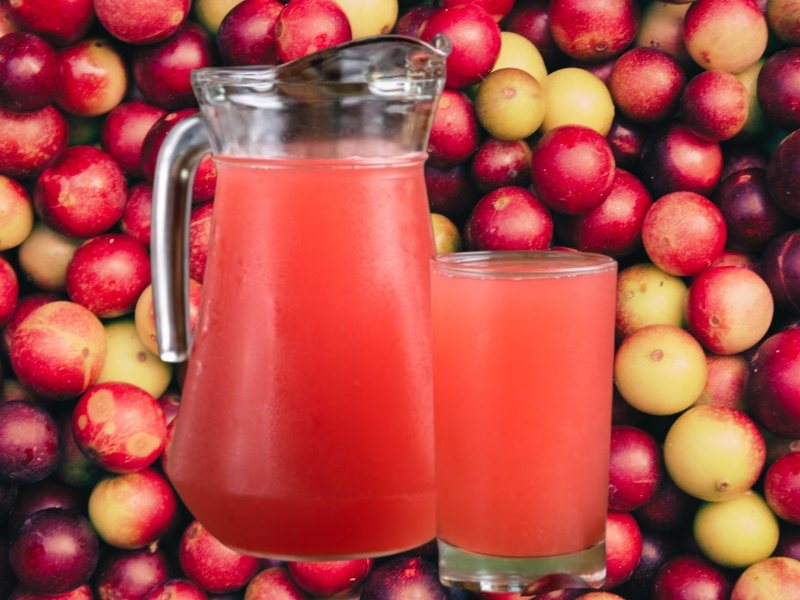
Camu camu is a shrub native to the Peruvian Amazon, which grows wild on the banks of rivers and in the floodplains of the Amazon. Camu camu fruits contain an incredible concentration of vitamin C, its greatest nutritional contribution. Vitamin C contributes to the formation of bones, teeth, skin, cartilage, ligaments and collagen, a protein involved in the development of tendons and blood vessels.
This Amazonian fruit also provides several kinds of amino acids such as serine, valine and leucine, as well as other nutrients such as sodium, potassium, calcium, zinc, magnesium, manganese and copper. It is an important source of nutritional antioxidants, β-carotene and phenolic compounds such as: ellagitannins, ellagic acid, quercetin glycosides, syringic acid and myricetin. Camu Camu soft drink is prepared with fruit pulp and ice, to refresh visitors from the heat of the Iquitos rainforest.
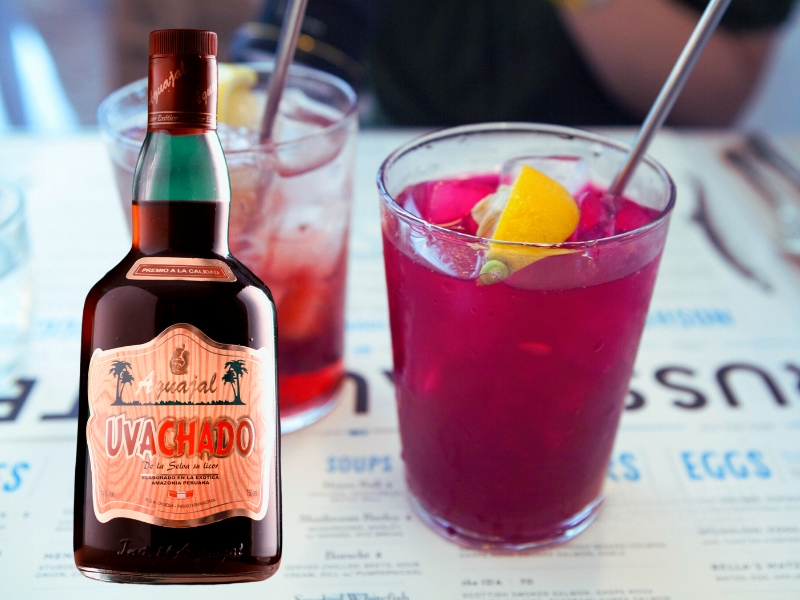
Uvachado is a drink made from the fermentation of wild grapes, sweetened with honey and mixed with the chuchuhuasi plant, known for its analgesic and anti-inflammatory properties. This combination creates a revitalizing drink that is used to relieve muscle pain and improve blood circulation. It is one of the most popular liquors in the jungle, especially in the city of Iquitos.
This drink is usually consumed during patron saint festivals as an accompaniment to meals. Due to its high alcohol content and aphrodisiac effects, it is recommended to drink in moderation. These medicinal and spiritual drinks are an integral part of the Amazonian worldview, where the connection with nature and ancestral knowledge are intertwined to promote health and holistic well-being.
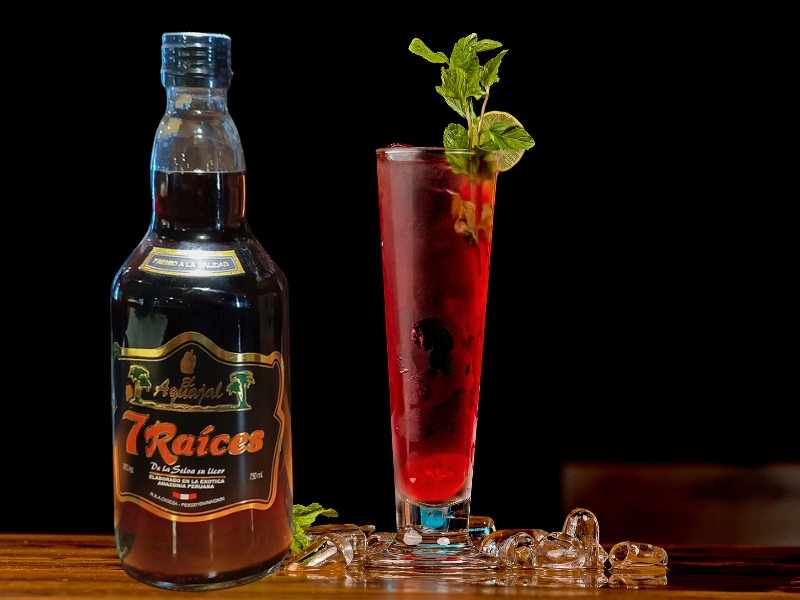
This is another of the most popular and well-known liquors from the Amazon. It consists of a preparation based on seven different roots and barks that are generally: Chuchuhuasi, Uña de gato, Fierro caspi, Moruro, Sanango, Sangre de grado and Cascarilla, these ingredients are macerated with sugarcane liquor and sweetened with honey.
This preparation has been part of the jungle tradition for centuries, characterized by its uninhibited and cheerful tone, so it was not frowned upon for people to resort to drinks like these, for example, to improve their sexual performance. In fact, it is said that each of the roots that make up this drink improve concentration, provide more energy, and alleviate intimate problems in men.
In Iquitos, you should not miss a famous street where these drinks abound, prepared by the wisest hands. Paquito Passage is a magical religious place, full of plants of all kinds, potions, amulets and everything that local shamans need for their work.
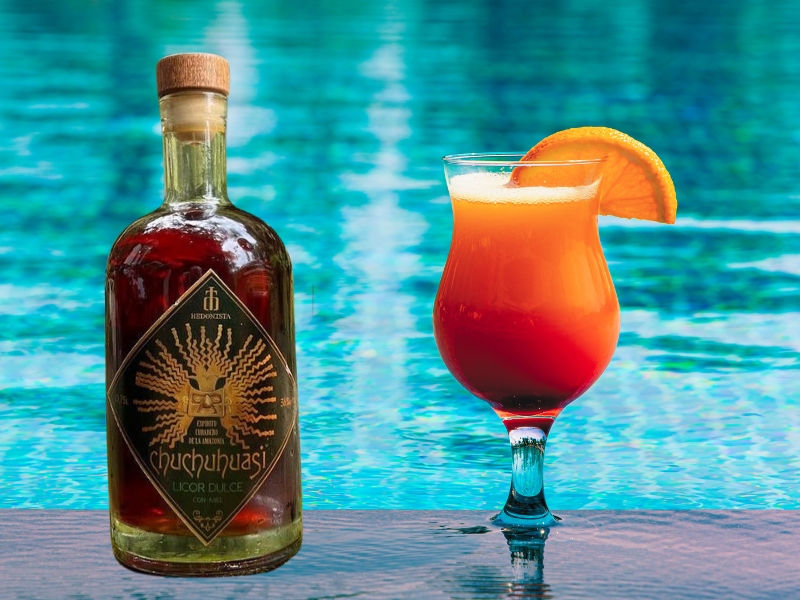
Chuchuhuasi is a tree native to the Amazon region. Chuchuhuasi liquor is made from the bark of the tree. This liquor is one of the strongest due to its high alcohol content, so it is always recommended to drink it in small quantities. Among its main properties is the stimulation of blood circulation, which favors the art of love.
With a rich history of use among Amazonian communities, Chuchuhuasi is valued for its medicinal and nutritional properties. It is also beneficial for rheumatic diseases such as arthritis, osteoarthritis and osteoporosis, as well as for muscle pain, bronchitis, stomach pain and fever.

Custard apple is a tropical fruit with a refreshing and aromatic pulp that is relatively rounded and green in color. It is a food rich in vitamins and minerals, making it very beneficial for health. Custard apple ice cream captures the sweet and creamy flavor of this tropical fruit and is part of the refreshing and seductive desserts from the Peruvian jungle. Custard apple, with its soft texture and delicate aroma, is the perfect base for a delicious homemade ice cream.
Custard apple has a great vitamin value of group B (no fresh fruit has such a high content of vitamins B1, B2 and B6), it is also a source of vitamin C and small amounts of vitamin A. It provides a high contribution of phosphoric acid and minerals such as calcium, potassium and iron. Its fiber content (1.9 g per 100 g of edible portion) helps improve intestinal transit and benefits multiple diseases and disorders, and its protein content is 2%, higher than that of many other fruits.
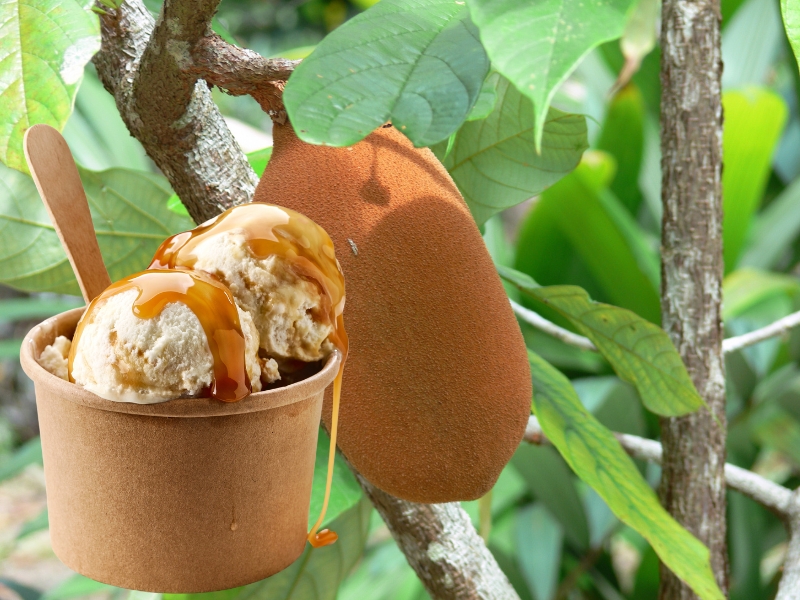
Copoazu is an Amazonian fruit also known as Amazonian white cocoa with a flavor reminiscent of cocoa and citrus. This dessert, with a smooth texture and unique flavor, is a true jewel of the desserts of the Peruvian jungle.
Copoazu has medicinal qualities, similar to those of cocoa, such as anti-inflammatory, prevents cardiovascular diseases, is a stimulant of the central nervous system and diuretic, such properties granted by the caffeine, theobromine and theacrine it contains. The pulp of the copoazu contains anthocyanins, flavonoids, tocopherols (vitamin E) and carotenoids. These antioxidant compounds help reduce the risk of chronic diseases.
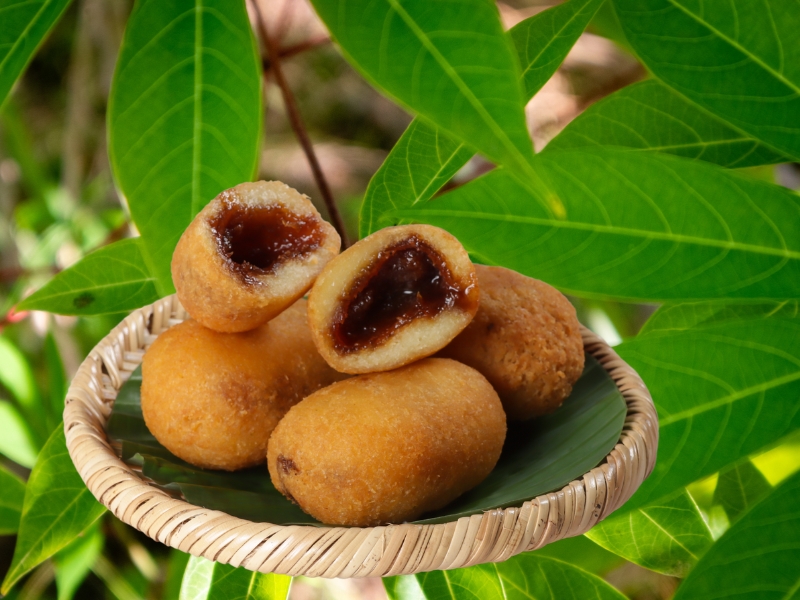
Cassava fritters are a crunchy-on-the-outside, soft-on-the-inside treat perfect for any occasion. Made from grated cassava, sugar, and a touch of cinnamon, this dessert is fried to a golden, mouthwatering texture that makes it a standout among Peruvian jungle desserts.
It is a popular jungle dessert, appreciated for its simple yet satisfying flavor. Fritters are ideal for sharing at gatherings or as a sweet treat any day.
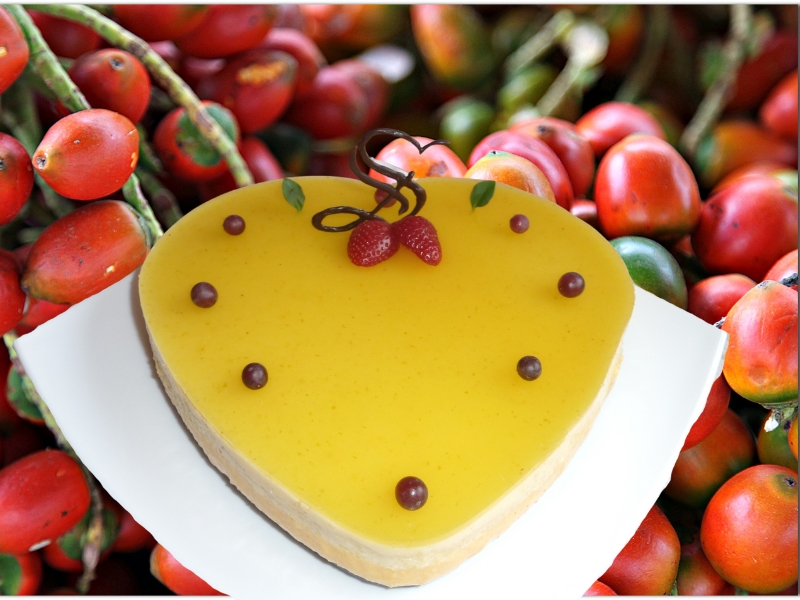
Pijuayo cheesecakeis a very common dessert from the Peruvian jungle. It is prepared with the fruits of the pijuayo tree, which are cooked with sugar until obtaining a gelatinous consistency. This sweet is ideal to enjoy as a dessert or as an accompaniment to other dishes.
These are just some of the ones you can try in Iquitos. Each one of them has a unique flavor and personality of its own, reflecting the richness of the gastronomy of this region of the Peruvian jungle.
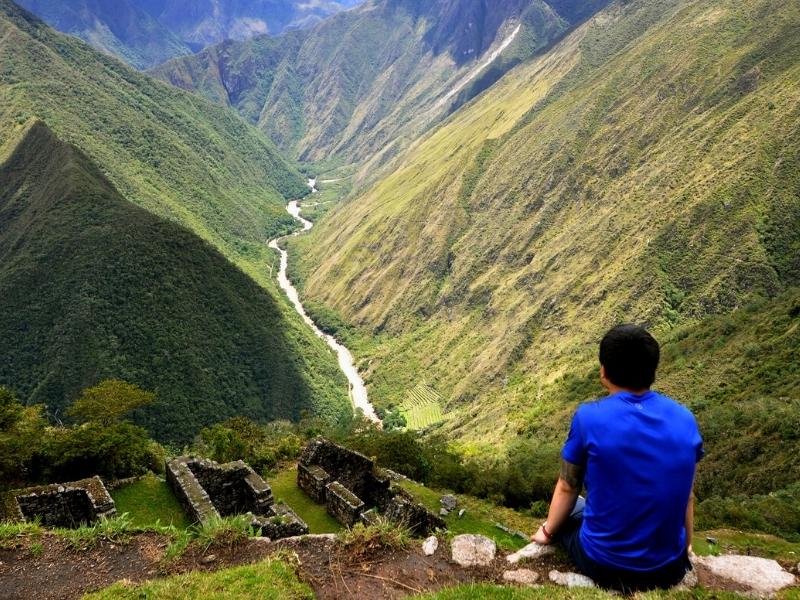
Explore the Manu Amazon Rainforest & Inca Trail hike to Machu Picchu, you will enjoy the best adventures in Peru, exploring amazing inca trail routes and the best amazon wildlife with our local tour guides, in small groups.
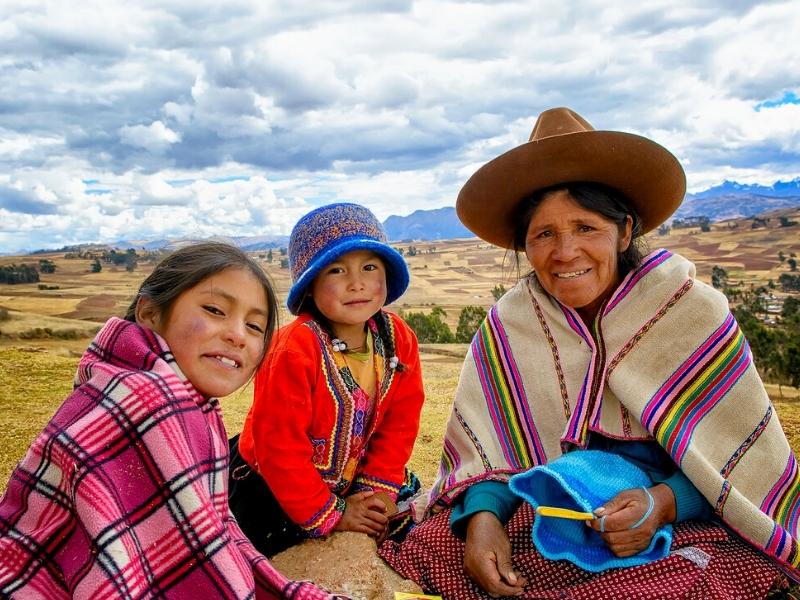
The top sights of Peru will leave all the family thrilled by the scenic grandeur, ruined temples, colonial cities, amazing inca trail to Machu Picchu, the Inca Lost City, once buried under the tropical forest which surrounds it.

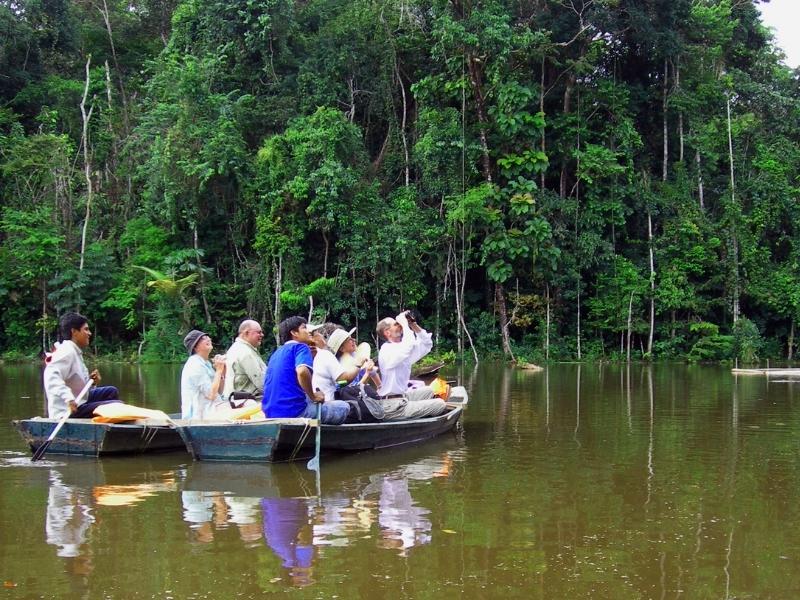
Your journey to the Tambopata National Reserve offers a great opportunity to discover a lively biodiversity of birds, mammals, reptiles, insects and trees. Record-setting numbers of animal species are concentrated within small areas, and the variety of plant life is greater than almost anywhere in the world.

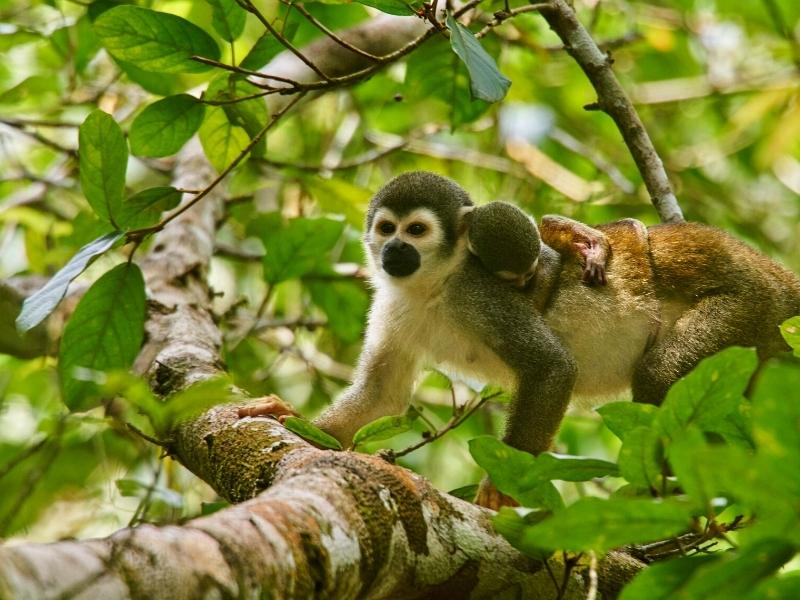
This trip allows you to have one of the best experiences in the Manu National Park which includes the Reserved Zone in only 7 days. It is an ideal way to experience the culture and traditions of local communities and see the distinct species of animals and birds that inhabit here.

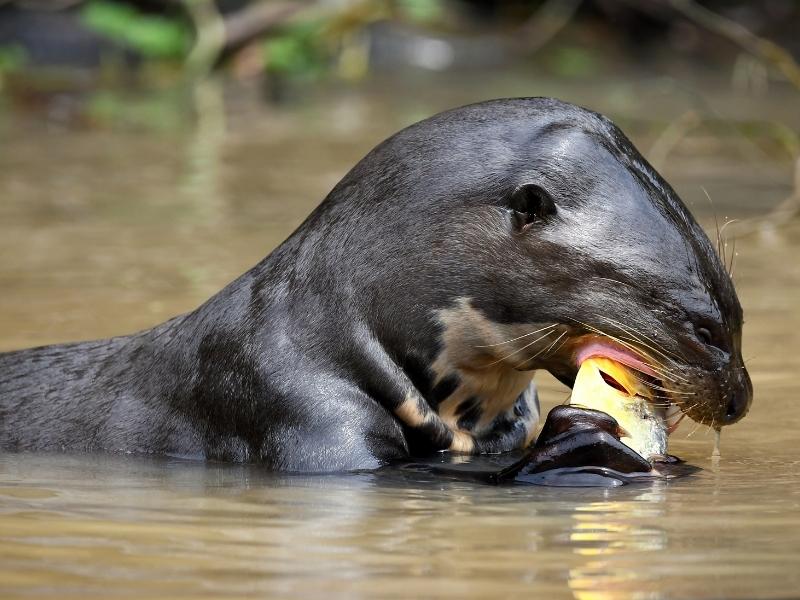
Discover the majestic Amazon rainforest of the Manu National Park. This protected area is in Peru, it is one of the largest ecosystems on the planet, due to its great diversity of birds, insects, plants and mammals.

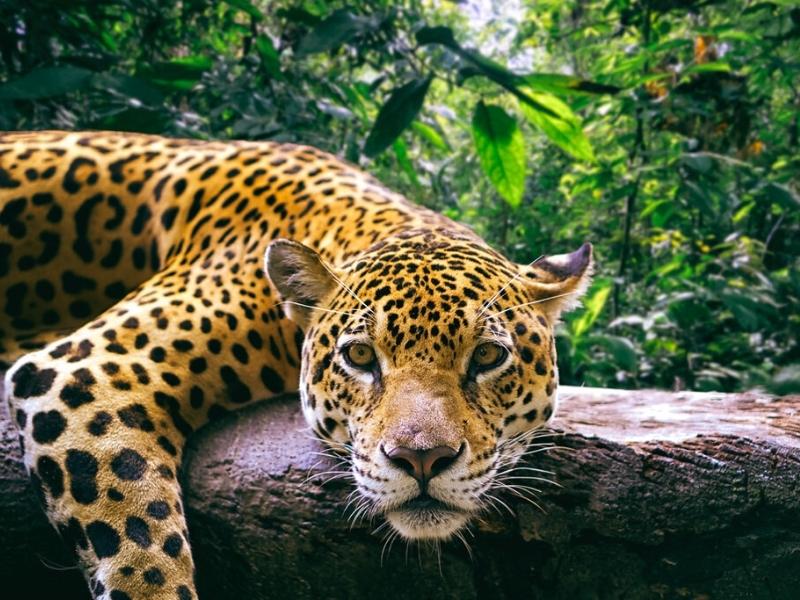
The Manu Jungle tour goes to one of the largest life biosphere reserves in the World. You will enjoy wildlife, traditional villages, with the best specialized guides.
